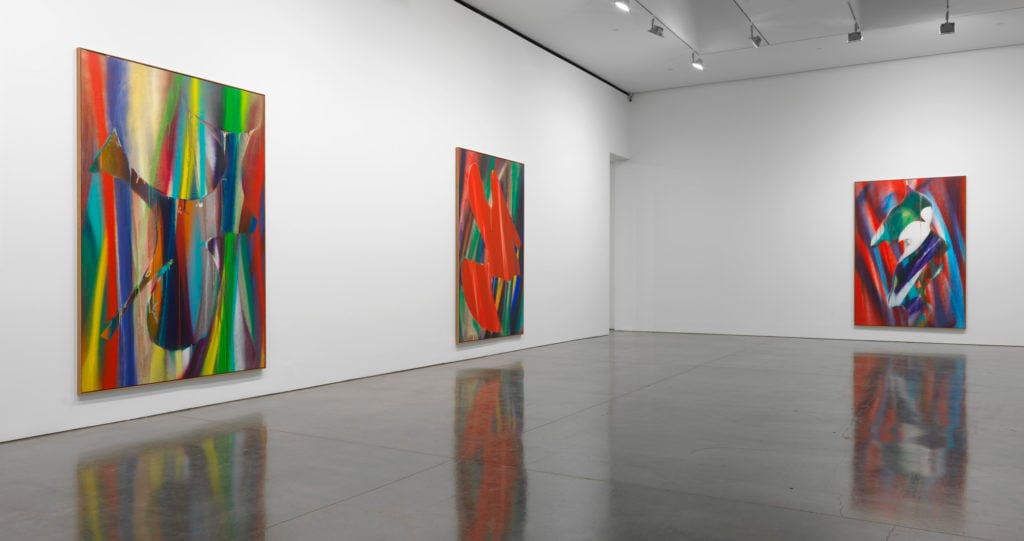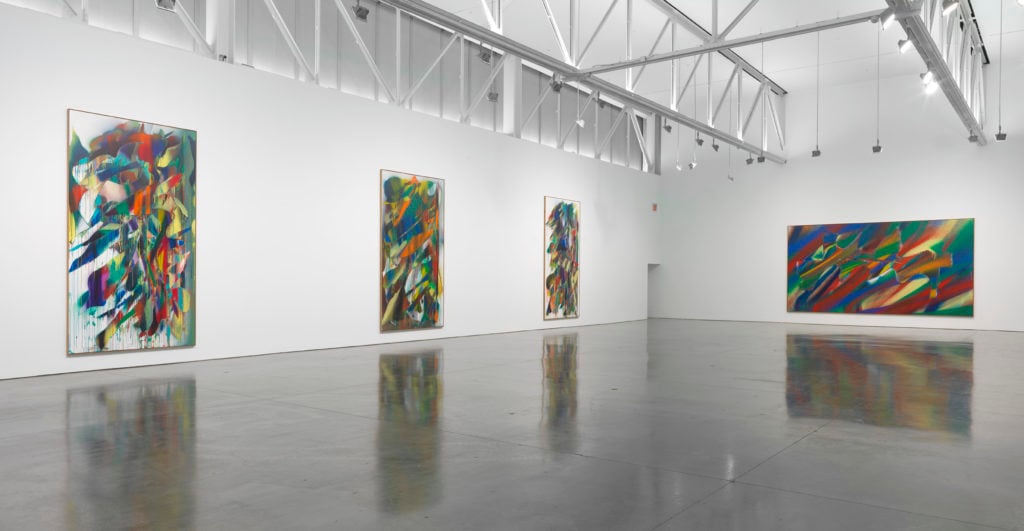On View
Katharina Grosse on Painting Without a Brush, and Her Gagosian Debut
She envisions her artworks almost as portals.
She envisions her artworks almost as portals.
Sarah Cascone

Unlike most painters, Katharina Grosse’s tools don’t include a paintbrush.
Instead, the Berlin-based artist’s unique creative process, which she’s been perfecting since 1998, centers around the industrial spray gun, employed as a means of applying brightly-colored acrylic paint to all manner of surfaces. Her bold, many-layered works are the subject of a solo exhibition at Gagosian’s Chelsea flagship, which is on view until March 11.
Known for her otherworldly installations, in which she dons a Hazmat suit-like to apply streams of color to large interior rooms, outdoor landscapes, and even entire buildings, Grosse appears to be a good fit for the Gagosian stable, which she joined. This is her first gallery show in New York.
Though her work may be new to many New Yorkers, Grosse has quite a past of her own. Her US debut occurred in 2001, with a large-scale installation at Los Angeles’s Hammer Museum. Others have followed, notably at MASS MoCA and in New Orleans for the Prospect 1 biennial in 2008.
That untitled project, in which Grosse transformed a post-Hurricane Katrina house in the Lower Ninth Ward into a captivating and controversial art installation, became the jumping off point for her first showing in New York. Commissioned by MoMA PS1, “Rockaway!” saw the artist turn her spray gun on an abandoned beachfront Army aquatics facility, giving the Hurricane Sandy-ravaged building a last life before its demolition.
On view at the gallery are paintings created by the artist over the last year. “I kind of locked myself away,” admitted Grosse to artnet News while taking a break from installations the day before the opening. She says that she didn’t share her progress with anyone until it came time to actually put the show together. Rather than focusing on individual works, she can have as many as 40 canvases in progress at any given time.
Once she loads the spray gun, the artist can paint continuously for about three or four minutes. “It feels endless,” she said.
The intensity and saturation of her colors is captivating. It’s quite hard to tell the order in which they were applied, with the layers, of varying degrees of opacity, seeming to recede and come forward almost as if they are alive.
“That’s the beauty of painting,” Grosse said. “Everything looks as if it happens at once, as if there is no past or future.”

Installation view of “Katharina Grosse” at Gagosian, 555 West 24th Street, New York. © Katharina Grosse und VG Bild-Kunst, Bonn 2016. Photography by Robert McKeever. Courtesy Gagosian.
At the time of her 2011 MASS MoCA exhibition “Katharina Grosse: One Floor Up More Highly” artnet News contributing writer David Ebony praised the artist’s “singular approach to painting that has taken the medium far beyond its traditional domain.” But what Grosse does in her painted installations, both indoor and out, also extends to her more traditional, canvas-based studio practice.
“When I paint outdoors it’s like painting a huge detail,” Grosse said. “You have a totally different point of view of the painting, and that is very useful for going back into the studio.”
Unlike Grosse’s installations, which coat the landscape in colorful hues, creating expansive worlds that stretch before you, her paintings, even the large-scale ones seen here, are much more compact. She envisions them almost as portals to a small room, where all the color has been crammed into a tiny space.

Installation view of “Katharina Grosse” at Gagosian, 555 West 24th Street, New York. © Katharina Grosse und VG Bild-Kunst, Bonn 2016. Photography by Robert McKeever. Courtesy Gagosian.
In painting her installations, Grosse has become interested in how the angles and protruding elements of buildings and spaces can block the flow of her paint spray, almost as a stencil would. She’s carried that over to her works on canvas, utilizing what she calls a filter system by laying large foam and cardboard stencils across the paintings as she works.
At the gallery, three rooms of canvases are accompanied by a single sculpture, a long, low-to-the-ground piece that is visible from the street. “I sometimes wanted a more rough, organic surface in indoor situations,” she explained of her decision to incorporate into her interior installations mounds of dirt and piles of Styrofoam carved into strange, organic shapes using a hot wire.
Her new sculpture both isolates this process and takes it one step further, casting one of these Styrofoam pieces in aluminum. Originally, Grosse was planning to host one of her signature installations as part of the Gagosian exhibition; this work is a remnant of that idea, and, perhaps, a hint of things to come. “This is a little bit like a prototype, in a sense,” she said, “for something larger.”
“Katharina Grosse” is on view at Gagosian Gallery, 555 West 24th Street, New York, January 19–March 11, 2017.